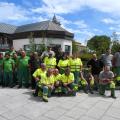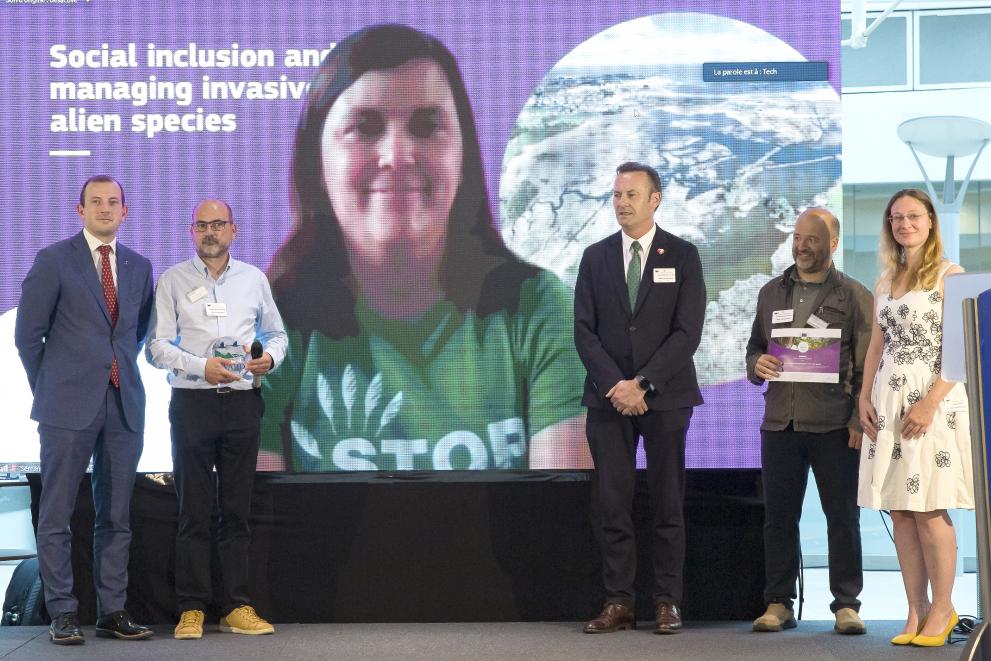
The LIFE Stop Cortaderia project wins the 2022 Socio-economic benefits category award. Commissioner Sinkevičius and Jury member Hélène Koch present project representatives with their award at the Natura 2000 Award Ceremony in Brussels.
About the project
- Main applicant
Sociedad Española de Ornitología (SEO/BirdLife)
- Category
Socio-economic benefits
- Countries involved
Spain
- Main N2000 site
Marismas de Santoña, Victoria y Joyel (ES1300007)
Overview
The LIFE Stop Cortaderia project aimed to eradicate pampas grass from five coastal Natura 2000 sites in Cantabria in Spain. However, the project had a very special angle compared to many conservation projects: it decided to simultaneously address the serious difficulties faced by people with disabilities when it comes to entering the labour market.
The LIFE Stop Cortaderia project therefore provides a win-win solution by promoting capacity-building and social integration of people with disabilities whilst providing concrete conservation benefits by providing concrete conservation benefits for natural habitat types of Community interest, such as coastal lagoons, in Natura 2000 sites.
On winning the award, Santiago García from the Asociación Amica, and coordinator of LIFE Stop Cortaderia, said: "The project is a very positive example of how people with disabilities can change their social role and be at the forefront of solutions to ecological and environmental problems, such as controlling Invasive Alien Species".
During the Award Ceremony, Mr García was joined on stage by Felipe González (SEO/Birdlife), Blanca Serrano (SEO/Birdlife) (on screen), and Guillermo Blanco (Regional Minister for Rural Development, Livestock, Fisheries, Food, and the Environment of the Government of Cantabria) to receive the award for the application “Social inclusion and managing invasive alien species”.
Pampas grass (Cortaderia selloana) is an invasive alien species (IAS) that affects numerous habitat types by displacing native plants and affecting soil quality. "The spread of pampas grass impacts unique species and habitats at coastal sites of Natura 2000 network. Our LIFE project has removed pampas grass and restored the habitat on 290 hectares of dunes, coastal lagoons, cliffs and coastal heaths in Cantabria’s coastal Natura 2000 sites," explained Mr González.
In order to enhance social integration for this target group, the Spanish NGOs Amica, Ampros and Sempra - which work on social integration and inclusion issues - created a close collaboration with the Spanish conservation NGO SEO/Birdlife, and the Câmara Municipal de Vila Nova de Gaia and the ESAC-Instituto Politécnico de Coimbra partners in Portugal.
The project, which is supported by the EU LIFE funding programme, employed 22 people with disabilities over a four-year period to work full-time in conservation field work. These people were involved in the mechanical eradication of the IAS, the management of green waste, and the replanting of natural vegetation in order to obstruct future re-growth of the IAS. A further 40 people with disabilities participated in volunteer actions, allowing them to witness first-hand the type of involvement that they can provide in the context of a biodiversity conservation project.
The project also demonstrates the effectiveness of partnerships between social and conservation NGOs, and the model is highly replicable particularly for conservation initiatives that require regular hands-on work, to which social partners can provide a very good input.
Local event
SEO/BirdLife celebrated winning the 2022 edition of the Natura 2000 Award in the Socio-economic benefits category by organising a local event on the 9 June 2023, highlighting the achievements of their application “Social inclusion and managing invasive alien species” which focused on activities carried out by the “LIFE STOP Cortaderia – Controlling IAS Cortaderia selloana on coastal lagoons in Cantabria” project. The event was held at the “Marismas de Santoña, Victoria y Joyel (ES1300007)” Natura 2000 site on the Cantabrian coast.
The event brought together a diverse group of participants, including Lucía Iglesias Blanco from the Nature Conservation Unit of the European Commission, local and regional authorities, people with disabilities involved in the project, several private companies, environmental as well as non-environmental NGOs, and various media outlets.
Through a guided walking tour, the participants explored sites restored during the project followed by a scientific bird-watching session and bird banding at the Marisma Victoria observatory. Afterwards, the project team planted some native trees in collaboration with the persons with disabilities who have been involved throughout the LIFE-funded LIFE STOP Cortaderia project.
To conclude the event, the project coordinator, Santiago García de Enterría, presented the main achievements of the project, including the elimination of 300 hectares of Pampas grass (Cortaderia selloana) in six coastal Natural 2000 sites in Cantabria and the planting of 16,000 autochthonous trees and shrubs. He specifically acknowledged the 32 people with disabilities who were involved in the project for over 3 and a half years, as well as how the project had in acting as a lever for change in their lives. The event was closed by Guillermo Blanco, Minister for the Environment of the Government of Cantabria.
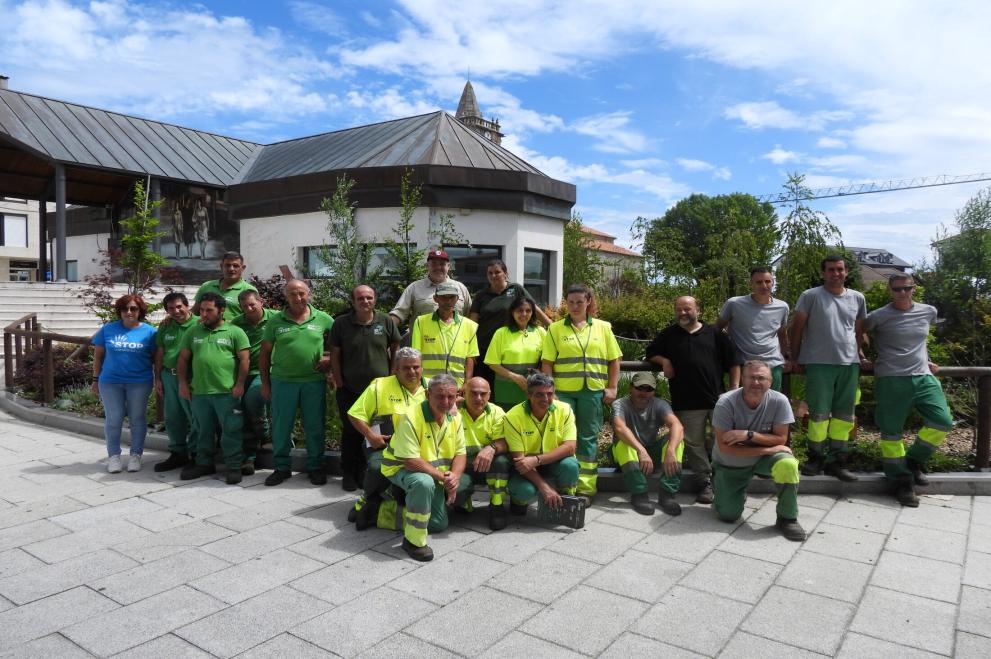
ES: LIFE STOP Cortaderia team members, from Amica, Ampros, Serca and SEO/BirdLifeES: LIFE STOP Cortaderia team members, from Amica, Ampros, Serca and SEO/BirdLife© Blanca Serrano | SEO/Bird Life Social inclusion and managing invasive alien species - Photo 4Social inclusion and managing invasive alien species - Photo 4SEO / BirdLife 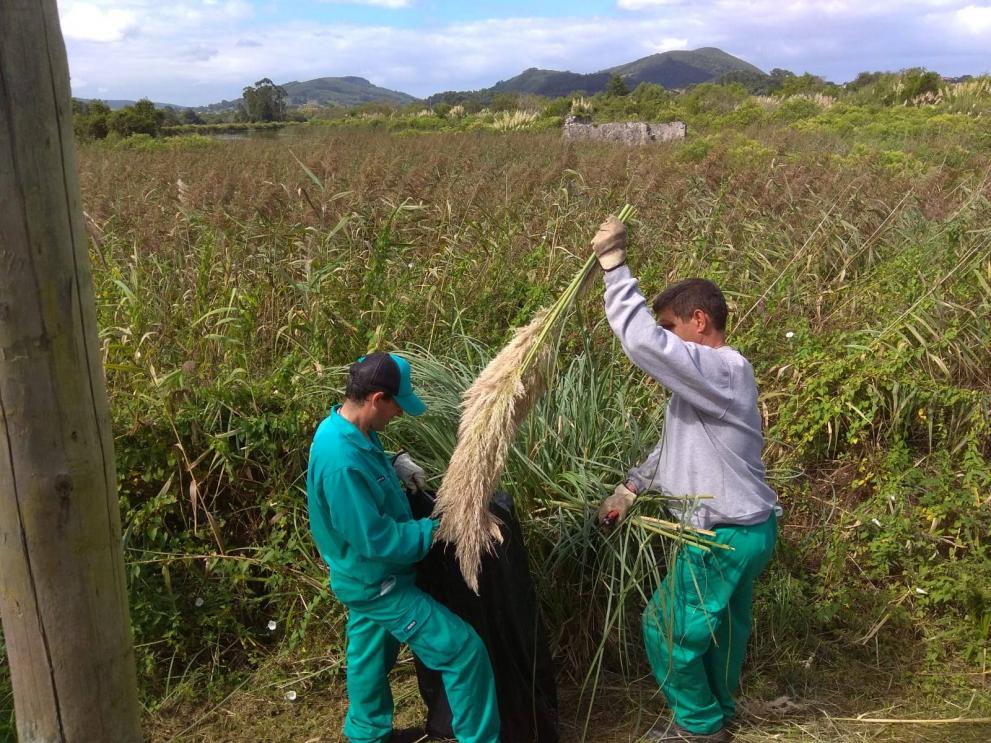
Social inclusion and managing invasive alien species - Photo 1Social inclusion and managing invasive alien species - Photo 1SEO / BirdLife Social inclusion and managing invasive alien species - MainSocial inclusion and managing invasive alien species - MainSEO / BirdLife 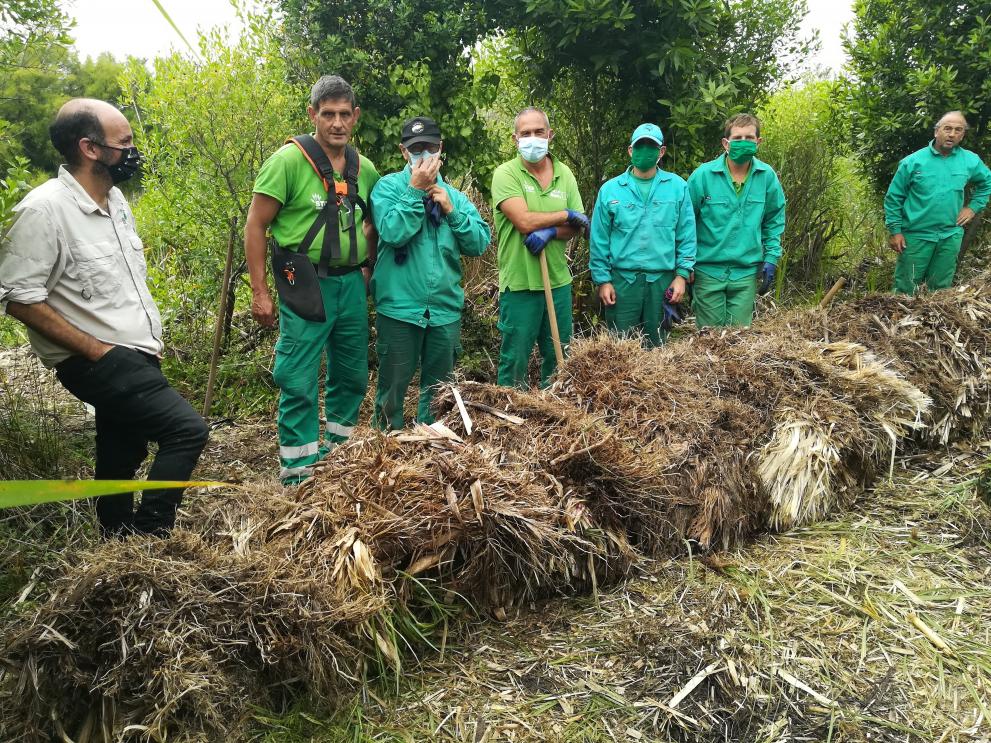
Social inclusion and managing invasive alien species - Photo 3Social inclusion and managing invasive alien species - Photo 3SEO / BirdLife 
Social inclusion and managing invasive alien species - Photo 2Social inclusion and managing invasive alien species - Photo 2SEO / BirdLife 
Social inclusion and managing invasive alien species - Video 1Social inclusion and managing invasive alien species - Video 1 
Social inclusion and managing invasive alien species - Video 2Social inclusion and managing invasive alien species - Video 2

